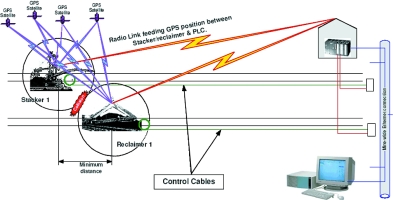
A collision between items of moving plant, such as the stacker and reclaimer, shown in the photograph, is difficult to anticipate and prevent. The concomitant collision damage to the plant, as well as lost production, can be significant. The traditional methods of collision detection are either based on linear transducers or infrared/radar distance detection systems. The linear transducers tend to 'slip' and must be zeroed from time to time. Maintenance of these systems is also very high. The infrared/radar systems must be kept immaculately clean at all times for proper operation. This is very hard to ensure in yards with fine powdery material such as coal, iron ore, etc.
Neither of the systems mentioned above can be considered as 'fail-safe'.
In applications where the mobile plant operates without being confined to rails, such as straddle cars in ports, the collision-detection technologies mentioned are totally inappropriate. These deficiencies are addressed with the wireless anti-collision system described below.
The Directech anti-collision anticipation and prevention system is based on precision, differential GPS position determination of the various items of plant. These positions are constantly fed to a central PLC system that continuously computes the relative positions of the various items.
If an impending collision is detected through two machines approaching within a pre-determined distance from each other, or a mobile item approaching a known fixed obstacle, the PLC immediately provide an output that can firstly be used to sound an alarm followed by a 'trip' signal to the offending pieces of plant.
Figure 1(a) shows a stacker/reclaimer set that can possibly collide as a result of operator error, during normal operation. Figure 1(b) shows free moving mobile plant, such as straddle cars moving between fixed obstacles, presenting multiple collision opportunities. The fixed obstacles must be identified and their locations stored in the PLC.


The stacker and reclaimer in Figure 1(a) will have a trailing control cable or wireless connection between a central PLC and the moving plant. The distance between the units that will sound an 'alarm', as well as the distance that will cause a 'trip', is settable by the user. The calculated relative distances between machines are accurate to within a metre.
This anti-collision detection system has no moving parts and thereby requires minimal maintenance. The radio antennae must be cleaned from time to time. The system is entirely fail safe and will not allow the plant to operate if there is a failure or system error in the Directech system. System diagnostics is available on a data port that can be accessed with a laptop PC. If the mobile machines do not have centrally located circuit breakers that can be tripped then Directech can extend the system so that the 'alarm' and 'trip' signals can be delivered to the specific pieces of plant by means of a secure radio signal that will comply with all legal requirements.
Where fixed obstacles must be recognised, high accuracy differential GPS signal processing is used to provide positional accuracy within half a metre for both the moving as well as fixed objects. High integrity, error-free data communication between the central control system and the mobile machines are provided by radio systems employing 'stealth' technology developed during the cold war. In Figure 1(b), the data communication can be direct communication between the central PLC and the PLC or other control system on the straddle cars. Alarm lights and or audio signalling devices are also used. The exact time and date of every potential collision occurrence and resultant Alarm/trip can be archived for subsequent, post event investigation.
In Figure 2, two integral radio transceivers, antennae and media converters mounted on the spindle of an ash stacker and connected to the control system with rugged polymer fibre-optic cables routed along the existing cable festoon.

For more information contact Directech, 011 708 2202, [email protected], www.directech.co.za
| Tel: | +27 11 708 2202 |
| Email: | [email protected] |
| www: | www.directech.co.za |
| Articles: | More information and articles about Directech |

© Technews Publishing (Pty) Ltd | All Rights Reserved